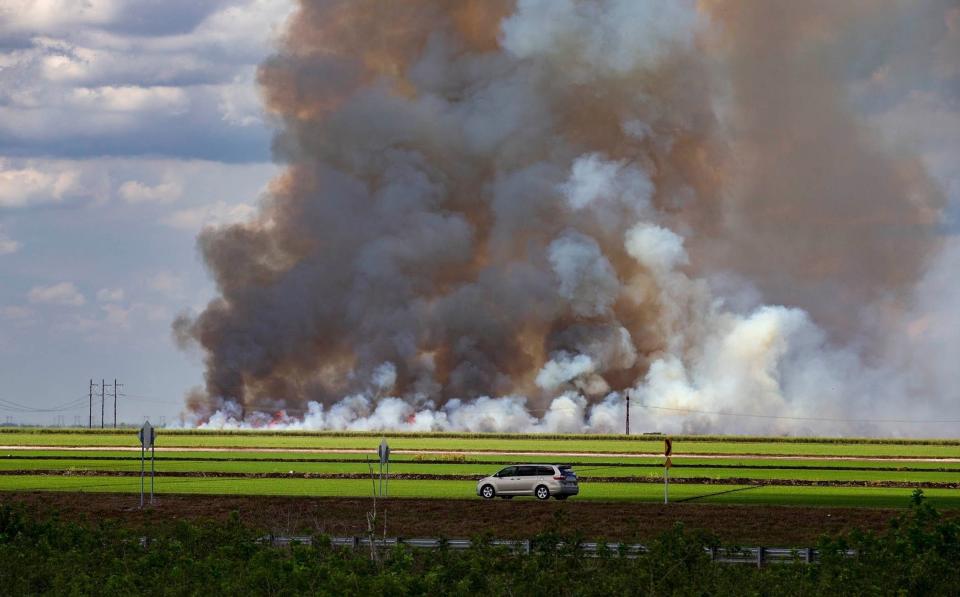Sugar cane fire pollution kills up to three South Floridians yearly, study finds
Two to three people in South Florida die prematurely each year because of exposure to pollution from sugar cane fires, a study released this month has found.
The study, led by Florida State University researchers, compared rates of death all over South Florida from illnesses linked to exposure to fine particle pollution from 2008 to 2018. Researchers examined the presence of pollution sources, which can also include emissions from other industries and vehicles. They isolated instances in which people were exposed to pollution from cane burning.
Data from 20 counties, including Palm Beach, Martin, St. Lucie, Indian River, Collier, Lee, Polk, Hendry, Glades, Manatee and Sarasota were included in the study.
Researchers used air monitors in Belle Glade and Royal Palm Beach, satellite images and state burn authorizations to track exposure to pollution released by sugar cane fires from October to March each year. Annually during that period growers set about 400,000 acres of field ablaze to burn off the tough outer layers of cane before harvesting their crops. Studies have shown that fine particle pollution is dangerous because it penetrates deeply into the lungs, causing potentially fatal conditions that include coronary artery disease, lung cancer and stroke.
Black snow investigation: Glades residents left behind: Nikki Fried’s ‘changes’ to cane burning served only Big Sugar
For subscribers: Read Palm Beach Post/ProPublica black snow investigation
Pulitzer finalist: Post/ProPublica investigation on sugar cane burning a finalist for the Pulitzer Prize
Concerns about the effects of pollution from the practice have led Brazil and other countries as well as states, including Louisiana, to abandon the practice in favor of environmentally friendly mechanical, or green harvesting. In addition to pollution, the cane field fires shower Glades communities, which include Belle Glade, Pahokee and South Bay, with soot that residents have come to call “black snow.”

One person in the Glades dies every six years because of cane fire exposure
In those communities, on average, one person every six years dies prematurely because of exposure to pollution from sugar cane fires.
“The impact per person is much higher in the Glades,” Christopher Holmes of FSU’s Department of Earth, Ocean and Atmospheric Science, one of the researchers on the study said Friday. “The number of deaths is lower because the population is much smaller.”
The study notes that effects of the pollution drop sharply outside the sugar growing region (SGR) because of a Florida Forestry Service practice of denying permits when winds would blow the smoke toward coastal communities.
“The effect of the wind criteria would also be considered a social justice issue because the smoke from sugarcane burning appeared to have disproportionate impacts for the lower income, minority residents of the (sugar growing region),” the researchers wrote.
The effects of pollution from the fires cause up to two premature deaths in Palm Beach County a year, with older residents in inland retirement communities the most susceptible, Holmes said.
Holmes also noted nonfatal effects from exposure to cane burning pollution, such as asthmatic episodes.
The study looked at deaths from lower respiratory infections among children younger than 5 and among people 25 years and older who account for most deaths from exposure to small particle pollution, he said. The study gathered data on the effects of the general population in their homes, Holmes said, and did not examine the effects on people who, working in the sugar cane fields, are occupationally exposed to the smoke.
Holmes emphasized that researchers do not advocate for any specific practice in response to their findings.
“We are not taking sides on what people should do,” he said. “We want to make sure that people are aware of the consequences of the current practice.”
While open burning in Florida also includes prescribed fires used in wildlands, “the vast majority of prescribed burning in the (sugar growing region) occurs on sugarcane fields,” according to the study.
Researchers note that prescribed wildland fires protect ecosystems and surrounding communities by reducing risks of wildfires, while sugar cane field fires “do not have these community benefits.”
In addition, researchers note, alternatives to pre-harvest burning include green harvesting, in which leaves can be left on the field to serve as mulch or transported with the stalk to be converted to fuel or other products.
'Growers have concerns about how green harvesting affects profits'
“Nevertheless,” the authors write, “Florida growers have concerns about how green harvesting affects profits, crop yields and crop management.”
The authors also write that recent legislation amending Florida’s Right to Farm Act limits sugar growers’ liability for the effects of fine particle pollution.
Green harvesting, however, the authors conclude, “could reduce the premature mortality in South Florida, with particular benefits for minority, lower-income communities within the (sugar growing region).”

Florida Assistant Agriculture Commissioner Shelby Scarpa noted that data from the study was gathered before Agriculture Commissioner Nikki Fried’s 2019 announcement of changes to the state’s prescribed burning program which, she said, factored in smoke dispersion models and led to a leap in burn permit denials. Roughly the same number of acres per year have been burned in the years following the announcement, however.
The first part of The Palm Beach Post/ProPublica “Black Snow” investigation, a Pulitzer Prize finalist, was carried out in the year following Fried’s announcement and documented continuing effects of the fires on people living in the Glades. Holmes consulted on research for that investigation.
In mid-August, a new Post investigation showed that the announced changes, many of which were rewordings of existing state rules, were never formalized in any way that would make them enforceable.
U.S. Sugar spokesperson Judy Sanchez said she could not respond to the study because she had not seen it. Randall Miller, a former environmental supervisor for air quality with the Palm Beach County Health Department, said he was responding on behalf the company, had reviewed the study and called its conclusions “meritless and without proof.”
The study, “Impacts of Sugarcane Fires on Air Quality and Public Health in South Florida,” led by Holly K. Nowell of FSU, was published Aug. 5 in Environmental Health Perspectives.
Antigone Barton is a journalist at The Palm Beach Post, part of the USA TODAY Florida Network. You can reach her at avbarton@gannett.com. Help support our journalism. Subscribe today.
This article originally appeared on Palm Beach Post: Sugar cane fire pollution causes premature deaths across South Florida

